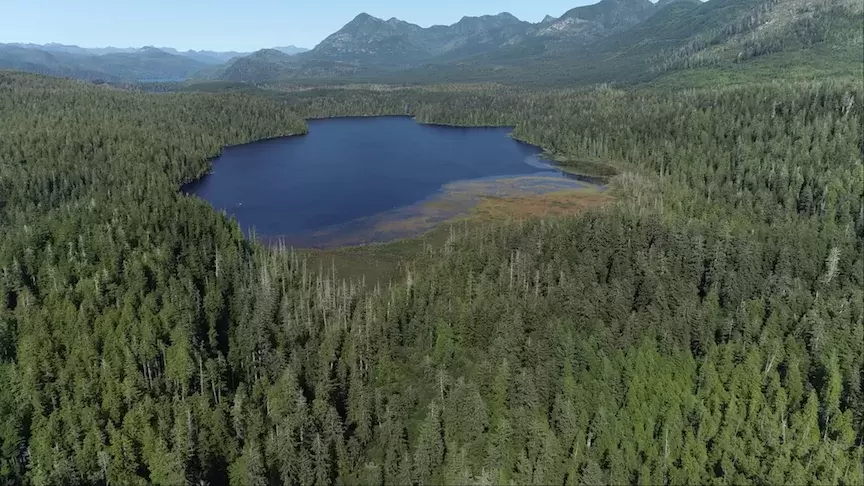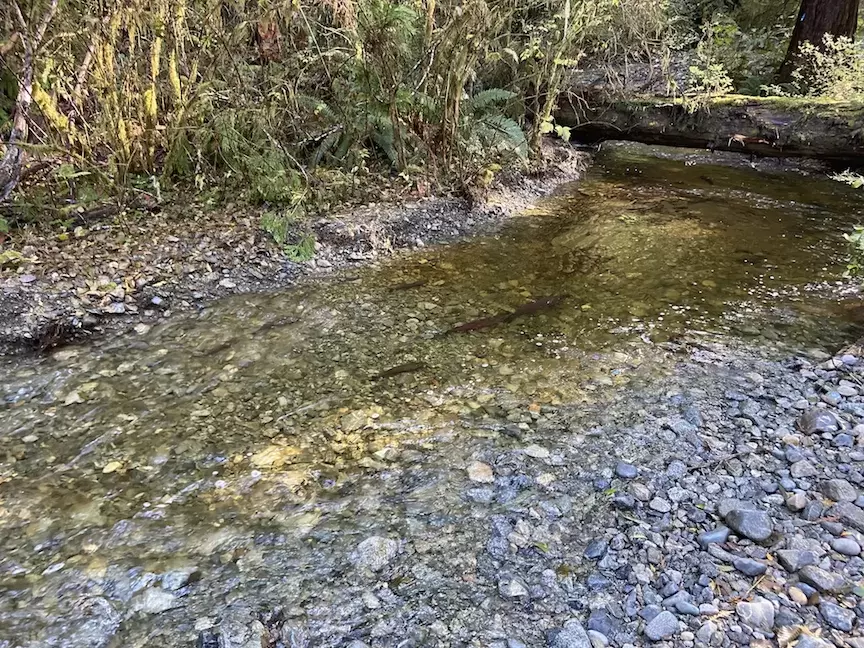Logging was already underway in the Cheewaht watershed when fisheries biologist Mike Wright first set eyes on the area south of Nitinat Lake 38 years ago.
By the mid-1980s, timber harvest started to increase, setting in motion a cascading chain of events that would threaten to wipe out Cheewaht salmon.
“Basically, they removed much of the canopy above the national park boundary,” Wright recalls.
The Nanaimo-based contractor is encouraged three years into a five-year restoration effort, having worked closely with Ditidaht First Nation and documented Cheewaht’s decline due to logging.
A small drainage compared to nearby Nitinat, Cheewaht used to punch above its weight as a reliably abundant source of salmon preferred by Ditidaht people. A five-kilometre river drains southwest to the Pacific, once producing sockeye, coho, chinook and chum as well as steelhead and cutthroat trout. Sockeye, one of the earliest runs in B.C., also rear in the lake, above which lie three small tributary streams that provided highly productive spawning beds.
“It was a very important food source for the villages of Clo-oose, Wyah and Cheewaht, and was managed in such a way that supported us pre-contact through fishing weirs,” said Paul Sieber, natural resource manager, Ditidaht First Nation.
Cheewaht watershed is more than a food source. A number of sacred Ditidaht sites and some of the world’s largest remaining cedars are found there.
“Families owned rights to certain spots on the Cheewaht River and built fish weirs to harvest their sockeye needs,” said Chief Councillor Brian Tate. “Young men would camp out on the Cheewaht River during the sockeye run and harvest for families at Wyah, Clo-oose and Cheewaht villages. These salmon harvest practices built family bonding and unity through helping and sharing with each other.”
Hydrological effects of logging on Vancouver Island’s west coast were already studied and well understood, even as the trees fell on slopes above Pacific Rim National Park Reserve. A multidisciplinary, multi-agency experiment began at Carnation Creek in Barkley Sound 50 years ago. Park boundaries were extended in the 1970s due to environmental concerns, but Parks Canada lacked authority to control upslope logging.
Typically, damage from logging doesn’t develop for a number of years, Wright said. In the Cheewaht, increased sedimentation occurred within five years. An irreversible process was rippling across the landscape. At one state, a debris jam blew apart, sending accumulated gravel downstream. Debris was eventually distributed across the anadromous zone inhabited by salmon. A debris zone created at the confluence of the small tributaries kept moving around.
“This is like a ping pong ball over a long period of time,” Wright said.
A shifting climate and marine conditions coincided with habitat decline due to logging and its effect on egg-to-fry survival. A 1992 El Nino event had a major impact on sockeye coastwide, Wright noted. The most significant geomorphological event occurred in 1997, when a new channel was cut down to the lake.
When Wright returned in 2001 to do stock assessment training and mapping with Ditidaht members, they knew degrading was occurring, he said. A watershed stakeholder group was formed in 2008. B.C. Timber funded additional studies in 2009, by which time conditions had degraded further.
“2009, that was when we really started to see the impact of logging done in the late ’80s and early ’90s,” Wright said. Sockeye escapement dropped to 10 percent of historic highs.
Paul Sieber, Ditidaht resource manager, said restoration planning began in earnest when the working group was restarted in 2017. Parks Canada pursued Species at Risk funding, which allowed major restoration efforts to proceed.
Last summer, workers from the Ditidaht community joined Parks Canada and contractors to remove more than 3,000 cubic metres of debris and sediment from the tributary streams. Banks were reinforced and logs strategically placed for enhanced spawning and rearing habitats along a one-kilometre stretch. The project was funded by a $1.1 million federal investment through Parks Canada’s Conservation and Restoration Program.
“It took a lot of collaboration between Parks Canada and First Nations and it worked out well,” Sieber said.
The work was challenging. A temporary corduroy road had to be built to bring in heavy equipment and only available materials could be used to recreate spawning habitat. They are encouraged last fall by the sight of adult sockeye, counting 3,400 fish and as many as 1,300 in a single day.
“That high return is a good start,” said biologist Ryan Abbott of M.C. Wright and Associates.
“It’s really good,” he stressed, noting each female can lay 3,000 eggs.
Sieber said they will continue monitoring the streams for the next four of five years to determine the effectiveness of the restoration work. The 2024 return should be telling.
“The Cheewaht sockeye run is only one of two and we concentrated on it first because it was highly endangered, and we needed to save it,” Sieber said. “We do want to expand restoration projects in that lake and watershed. There are ongoing talks with DFO. It’s a huge task. We do monitor the Nitinat River, but that’s all. We want to do work in all salmon streams.”
Forests can take 40 to 100 years to recover from logging. It could take 20 years or more to determine the effectiveness of restoration, Wright said. With climate change and intense storms, slopes are more saturated, he noted.
“We’re always waiting for something to let go,” he cautioned.
They have five remote cameras set up, shooting every half hour in daylight, to keep close watch.
Wright feels the project demonstrates greater potential for rebuilding salmon habitat elsewhere.
“It is probably one of the highlights of my career,” he said.
The question of how to prevent destructive logging practices often comes up at the roundtable.
“We have to do a better job of managing the landscape,” Wright said. “How do you get government to rethink how logging practices occur? What are adequate buffers to sustain stream beds?”
While Parks Canada continues to monitor the watershed, Ditidaht First Nation intends to assume that role in the long term with development of its guardian program.










